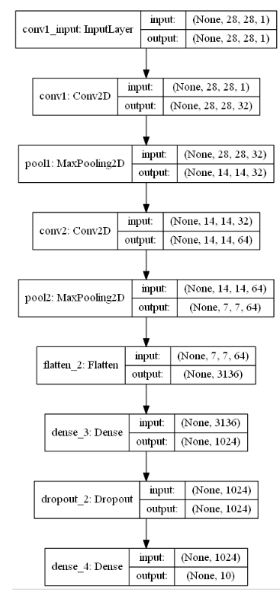import numpy as np from keras.datasets import mnist from keras.utils import np_utils from keras.models import Sequential from keras.layers import Dense,Dropout,Convolution2D,MaxPooling2D,Flatten from keras.optimizers import Adam from keras.utils.vis_utils import plot_model import matplotlib.pyplot as plt # install pydot and graphviz
1 # 载入数据 2 (x_train,y_train),(x_test,y_test) = mnist.load_data() 3 # (60000,28,28)->(60000,28,28,1) 4 x_train = x_train.reshape(-1,28,28,1)/255.0 5 x_test = x_test.reshape(-1,28,28,1)/255.0 6 # 换one hot格式 7 y_train = np_utils.to_categorical(y_train,num_classes=10) 8 y_test = np_utils.to_categorical(y_test,num_classes=10) 9 10 # 定义顺序模型 11 model = Sequential() 12 13 # 第一个卷积层 14 # input_shape 输入平面 15 # filters 卷积核/滤波器个数 16 # kernel_size 卷积窗口大小 17 # strides 步长 18 # padding padding方式 same/valid 19 # activation 激活函数 20 model.add(Convolution2D( 21 input_shape = (28,28,1), 22 filters = 32, 23 kernel_size = 5, 24 strides = 1, 25 padding = 'same', 26 activation = 'relu', 27 name = 'conv1' 28 )) 29 # 第一个池化层 30 model.add(MaxPooling2D( 31 pool_size = 2, 32 strides = 2, 33 padding = 'same', 34 name = 'pool1' 35 )) 36 # 第二个卷积层 37 model.add(Convolution2D(64,5,strides=1,padding='same',activation = 'relu',name='conv2')) 38 # 第二个池化层 39 model.add(MaxPooling2D(2,2,'same',name='pool2')) 40 # 把第二个池化层的输出扁平化为1维 41 model.add(Flatten()) 42 # 第一个全连接层 43 model.add(Dense(1024,activation = 'relu')) 44 # Dropout 45 model.add(Dropout(0.5)) 46 # 第二个全连接层 47 model.add(Dense(10,activation='softmax')) 48 49 # # 定义优化器 50 # adam = Adam(lr=1e-4) 51 52 # # 定义优化器,loss function,训练过程中计算准确率 53 # model.compile(optimizer=adam,loss='categorical_crossentropy',metrics=['accuracy']) 54 55 # # 训练模型 56 # model.fit(x_train,y_train,batch_size=64,epochs=1) 57 58 # # 评估模型 59 # loss,accuracy = model.evaluate(x_test,y_test) 60 61 # print('test loss',loss) 62 # print('test accuracy',accuracy)
plot_model(model,to_file="model.png",show_shapes=True,show_layer_names=True,rankdir='TB') plt.figure(figsize=(10,10)) img = plt.imread("model.png") plt.imshow(img) plt.axis('off') plt.show()
